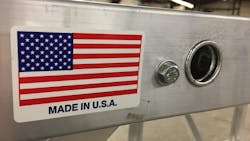Employment in U.S. manufacturing currently stands at just under 13 million workers. Manufacturing’s peak of 19.5 million jobs occurred in June 1979.
While some of this 40-year decline resulted from the change in skills manufacturers needed from workers over time, another catalyst is the ruthless race to find cheaper labor, parts and production in other countries.
In his book “Made in the USA: The Rise and Retreat of American Manufacturing,” author Vaclav Smil points out that “an excessive dependence on imports, and the systematic outsourcing of entire industries, will eventually weaken the strongest economies.”
U.S.-made is a point of pride for me and many manufacturers. “Made in the U.S.A.” means more than just higher quality. Made in the U.S.A. means stronger supply chains and potentially a lower total cost to operate my business. The U.S.-made label also entails providing better-paying jobs for American workers who can thrive.
Making products is a passion of mine, especially the operational side of manufacturing. When given a clear goal and the standards and resources to get the job done, the American worker is the best in the world.
According to the Federal Trade Commission, to call a product U.S.-made, it “must be ‘all or virtually all’ made in America.” The FTC goes on to say that the “product should contain no — or negligible — foreign content.”
Our company fully follows this guidance and produces what our customers say is a superior product.
While it would be cheaper to buy our aluminum castings and extrusions, fittings and rivets from China, Vietnam or Turkey, we buy from U.S.-based suppliers. A cheaply made rivet could be a weak point in an otherwise quality product that carries our name and our country’s name. That said, our product does contain some foreign content because we cannot buy domestically produced aluminum ingots; they aren’t mined in the U.S. The U.S.-based company we rely on purchases those ingots from countries like Turkey but does the extrusion in Ohio.
Look Back, Look Local
As much as possible, we want our materials and supplies U.S.-made to ensure the simplicity and consistency of our supply chain. By doing that, we eliminate the possibility of a shipment being caught at a border crossing or port. If we’re looking for tooling or degreasers, we first hunt for a local supplier and fan out from there. Local suppliers stand up for their product by coming to us to repair, replace and replenish it, and our downtime is minimal. Our goal: Always go as far back as possible in the supply chain to find and buy American-made products to make our wares.
Saving Dimes May Cost Dollars
It weakens our economy to chase what are perceived to be the lowest-cost goods. Compounding that problem is the fact that nearly every industry and company rewards procurement professionals for securing products and services at the lowest unit or invoice price. American-made products are often more expensive per unit than imported goods. Asking for a change of viewpoint—such as calculating total cost of ownership, or TCO—typically engenders a collective shrug, or worse, from supply chain leaders and procurement staff. That’s because it’s difficult to track the downstream costs over a product’s lifespan, and it’s hard to report cost savings beyond unit price.
But there are hidden costs to a unit-price approach, such as freight costs, import duties and the effects of poor quality: rejections, recalls and inefficiency. For example, when searching for safety gear like hardhats, let’s say procurement finds a helmet for $17 per unit. That’s the lowest cost. But what happens when workers find the helmet has no shielding on the back or side and the suspension system is difficult to install? Workers may not use the product, instead choosing to keep donning a worn-out helmet that risks injury.
Earlier in my career, when I was a sales representative, the procurement team at one of my accounts got a percentage of every dollar they saved on purchasing equipment by unit cost. They were motivated to buy the least expensive tool or part.
In turn, the company’s workers complained about how parts were breaking or tools didn’t have the torque necessary to get a job done efficiently. This made an employee’s job harder, slowed production, hurt quality and sowed animosity between the workforce and management.
A Framework for Quality and Savings
To retool a company’s procurement approach and give American-made quality the opportunity to win, consider TCO. Getting started with TCO isn’t easy, but we’ve done it by focusing on four areas:
- Review historical data on costs to determine a baseline for evaluating the TCO effort.
- Calculate direct costs. These, of course, include the purchase price and shipping.
- Evaluate the part’s lifespan vis-à-vis the competition’s offering. How long will each hold up under real-world use? This will likely require research and/or speaking with users or a head-to-head test. Get the end-users’ feedback to properly understand the impact of the change.
- Estimate operating costs and indirect costs such as maintenance, warehousing and training. A less costly part may lead to more frequent repairs.
If C-level executives incentivize procurement professionals to consider long-term value and TCO, supply chain leaders will see opportunities where quality--often American-made—goods end up being less expensive. Some ways to begin refocusing on TCO include:
- Open communications to build relationships and trust between a product’s buyers and users. This leads to working collaboratively rather than acting independently.
- Build cross-functional incentive plans. For example, give the procurement group a bonus (as a percentage) for helping its company’s manufacturing group achieve the fiscal year maintenance, repair and operations goals; the tool shop would get a bonus based on how well the buying group achieved its purchasing goals.
- When a vendor makes a sales call, invite users to evaluate the product’s total impact on the company’s cost and performance.
- Cross-functional teams inject collaboration into the buying decision, reward partnership and create opportunities to see a broader view of the company.
Early in my career, my company had a customer who insisted on spending money on an ineffective direct-mail program. We had a solution that would work better but clearly cost more at the outset. When we asked why he continued with his approach, he said, “It may not work well, but it’s cheap.”
If you pay for quality, quality will pay you back. Buying American-made quality often is less expensive over time. A long-term, strategic mindset including TCO may well reverse the effect that buying cheap parts has had on our economy and manufacturing industry.
Patrick Reagan is president of Randolph, New York, -based Metallic Ladder.
About the Author

